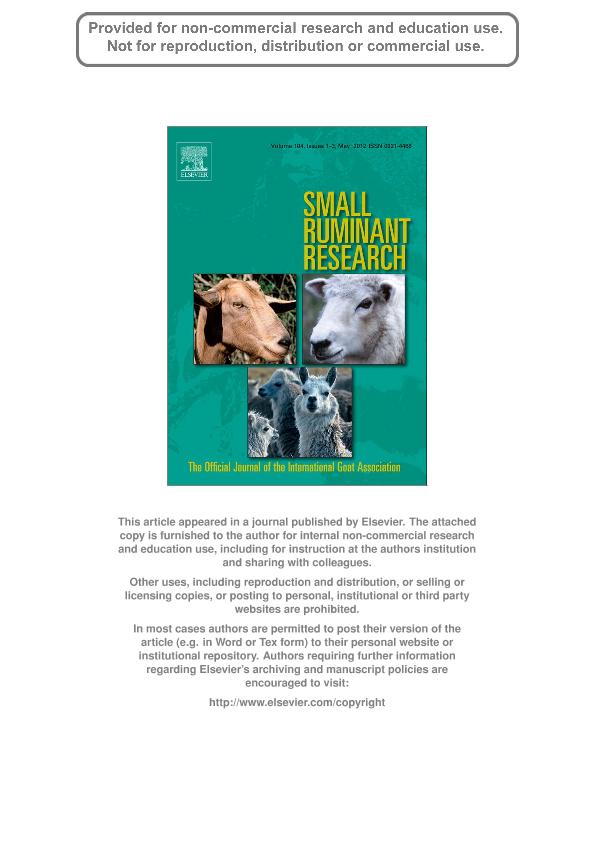Mostrar el registro sencillo del ítem
dc.contributor.author
Mosca Torres, Maria Eugenia

dc.contributor.author
Puig, Silvia

dc.date.available
2018-06-12T20:30:54Z
dc.date.issued
2012-05
dc.identifier.citation
Mosca Torres, Maria Eugenia; Puig, Silvia; Habitat use and selection by the vicuña (Vicugna vicugna, Camelidae) during summer and winter in the High Andean Puna of Argentina; Elsevier Science; Journal of Small Ruminant Research; 104; 1-3; 5-2012; 17-27
dc.identifier.issn
0921-4488
dc.identifier.uri
http://hdl.handle.net/11336/48446
dc.description.abstract
Habitat use and selection by vicuñas and particularly by individuals of different social categories were evaluated during the summer and winter of two years (2006 and 2007) that differed in their precipitation pattern. Both, use and selection, were analyzed within the framework of the optimal foraging theory (OFT) that predicts a high proportion of individuals using habitats where the most nutritional food items are present, and if other things are equal, habitats should be chosen if they yield the highest average rate of energy intake, which fits with this theory. Indeed, a prediction of the habitat selection theory (HST) was evaluated during winter (dry season). Over the study period high proportions of vicuñas occupied habitats with availability of high quality food, which supports the OFT. However, habitat selection differed between seasons and years due to the decrease in plant resource availability in the winter of both years and in the summer of 2007 (with drought conditions). In the dry season of the good year (2006), vicuñas (familial individuals, particularly) were more homogeneously distributed among habitats than in summer, which is consistent with the HST. High proportions of individuals at the wetland (called vega) were more evident during the bad year (2007) than in the good one. Therefore, habitat use (and selection) by vicuñas in this sector of the Puna region is influenced by the availability of high quality food resources and by the presence of water, and the relevance of the latter increased with drought conditions. An assessment of the interactions between individuals of different social categories will contribute to better understanding the distribution of animals among different habitats.
dc.format
application/pdf
dc.language.iso
eng
dc.publisher
Elsevier Science

dc.rights
info:eu-repo/semantics/openAccess
dc.rights.uri
https://creativecommons.org/licenses/by-nc-sa/2.5/ar/
dc.subject
Optimal Foraging Theory
dc.subject
Drought Conditions
dc.subject
Social Structure
dc.subject
Water Requirements
dc.subject.classification
Otras Ciencias Biológicas

dc.subject.classification
Ciencias Biológicas

dc.subject.classification
CIENCIAS NATURALES Y EXACTAS

dc.title
Habitat use and selection by the vicuña (Vicugna vicugna, Camelidae) during summer and winter in the High Andean Puna of Argentina
dc.type
info:eu-repo/semantics/article
dc.type
info:ar-repo/semantics/artículo
dc.type
info:eu-repo/semantics/publishedVersion
dc.date.updated
2018-04-24T16:45:40Z
dc.journal.volume
104
dc.journal.number
1-3
dc.journal.pagination
17-27
dc.journal.pais
Países Bajos

dc.journal.ciudad
Amsterdam
dc.description.fil
Fil: Mosca Torres, Maria Eugenia. Consejo Nacional de Investigaciones Científicas y Técnicas. Centro Científico Tecnológico Conicet - Mendoza. Instituto Argentino de Investigaciones de las Zonas Áridas. Provincia de Mendoza. Instituto Argentino de Investigaciones de las Zonas Áridas. Universidad Nacional de Cuyo. Instituto Argentino de Investigaciones de las Zonas Áridas; Argentina
dc.description.fil
Fil: Puig, Silvia. Consejo Nacional de Investigaciones Científicas y Técnicas. Centro Científico Tecnológico Conicet - Mendoza. Instituto Argentino de Investigaciones de las Zonas Áridas. Provincia de Mendoza. Instituto Argentino de Investigaciones de las Zonas Áridas. Universidad Nacional de Cuyo. Instituto Argentino de Investigaciones de las Zonas Áridas; Argentina
dc.journal.title
Journal of Small Ruminant Research

dc.relation.alternativeid
info:eu-repo/semantics/altIdentifier/doi/http://dx.doi.org/10.1016/j.smallrumres.2011.11.002
dc.relation.alternativeid
info:eu-repo/semantics/altIdentifier/url/https://www.sciencedirect.com/science/article/pii/S092144881100441X
Archivos asociados
